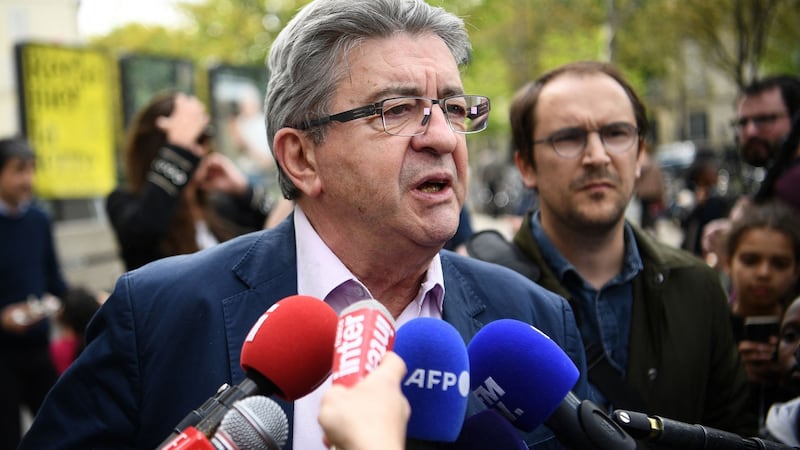French voters have elected a fractured National Assembly carved up into three blocs with none close to the outright majority needed to form a government — raising the spectre of a long period of political paralysis.
With most voting constituencies counted, the left-wing alliance Nouveau Front Populaire led with 180 seats, according to tallies compiled by Le Monde newspaper, followed by outgoing president Emmanuel Macron’s Ensemble centrist alliance with 159. Marine Le Pen’s far-right Rassemblement National secured 143 seats.
Negotiations among party chiefs will now determine whether a coalition government can be crafted with an outright majority of 289 seats — or, failing that, a minority government that can survive a no-confidence vote.
[ Jack Power: Macron’s grenade blows up the French systemOpens in new window ]
A fallback option would be a technocratic government led by a non-partisan prime minister until another election can be called next year.
RM Block
Politicians from each bloc began to stake their claims on Sunday. Le Pen’s RN will remain isolated in the assembly but will represent a threat to any government if it chooses to join no-confidence votes.
An Élysée Palace official said Macron would “wait for the structure of the new National Assembly to make the necessary decisions”, a nod to the president’s role in naming the prime minister.
Can the leftwing NFP lead a minority government?
As the surprise winner of the snap legislative elections, NFP leaders said they would seek to form a government to carry out their progressive agenda, which includes heavy tax-and-spending plans and the re-establishment of a wealth tax.
But the NFP is made up of several parties — from the far-left La France Insoumise to the more moderate Socialists, Greens and Communists — and internal wrangling will precede a push to take the premiership.

The question of who could be prime minister will be particularly sensitive, with polarising LFI leader Jean-Luc Mélenchon offering his services despite his partners’ objections. Within the NFP, LFI is the largest force with 72 seats, according to Ipsos projections, but the other parties together outnumber it.
Maintaining unity will be key because Macron’s centrists will seek to peel off the NFP’s centre-left elements and bring them over to their side.
Green leader Marine Tondelier, who has become influential within the NFP, declared that they intended to govern. “We are determined... to put into action our programme of change,” she said.
But since even a united NFP would be well short of a majority, the centrists in the assembly would have to agree not to pull the trigger on it via a confidence vote.
Can Macron’s centrists form a German-style grand coalition?
Macron’s Ensemble alliance has suffered a big defeat, losing roughly a third of the 250 seats it held. But its members still believe they can shape a deal in parliament.
A freshly re-elected MP said: “It looks like we are going to be pivotal in all the discussions. No one can achieve a majority without us.”
At the heart of Macron’s strategy is a desire to eject LFI from the NFP and form an alliance with the Socialists, the Greens and the Communists.
Former foreign minister Hubert Védrine predicted Macron would maintain Prime Minister Gabriel Attal as a caretaker, particularly during the Olympics starting on July 26th, before trying to form a centre-left coalition. But he wondered whether “the reasonable left” would manage to cut ties with LFI.

The demands of centre-left groups may also be hard to swallow for the president’s party. They could try to demand that Macron repeals his unpopular rise in the retirement age, or guts an immigration law passed last year. The left would also be likely to demand tax increases that centrists have ruled out.
Some Macron allies may want to include members of the conservative Les Républicains grouping in any coalition. But many centre-left requests would be unacceptable for the rightwing LR. “The Republican right needs to remain independent,” said Geoffroy Didier, a LR MP.
Can a technocratic government be the solution?
If no coalition emerges, Macron could appoint a government headed by a high-level civil servant or non-partisan figure to run the country at least until June 2025, when another election could be called.
This government’s first task would be to pass a budget in the autumn. But it would be vulnerable to votes of no-confidence. If it falls, the political gridlock could test the institutions of the Fifth Republic as never before.
Limping on until next June would “be the worst-case scenario,” said François Patriat, a senator and close Macron ally. The president would call all party leaders starting on Monday for consultations, he said. “Tonight everybody is digging in, it’s election night. But we’ll need to talk.”.
Mujtaba Rahman, managing director at the Eurasia Group, a political risk consultancy, was less optimistic. “France now faces a period of deep, political confusion, which could be exploited by Le Pen,” he said.
“The other squabbling, political forces of left, right and centre will struggle to agree anything in the months ahead to soften the French electorate’s anger or anxieties,” Rahman added. – Copyright The Financial Times Limited 2024
- Listen to our Inside Politics Podcast for the latest analysis and chat
- Sign up for push alerts and have the best news, analysis and comment delivered directly to your phone
- Find The Irish Times on WhatsApp and stay up to date













